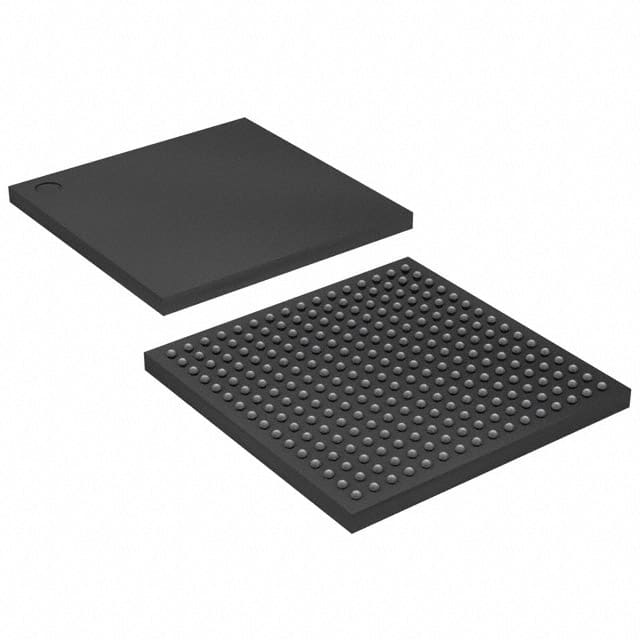XC2C384-10FT256I
Product Overview
Category
XC2C384-10FT256I belongs to the category of programmable logic devices (PLDs).
Use
This product is primarily used for digital circuit design and implementation. It provides a flexible and customizable solution for various applications.
Characteristics
- Programmable: XC2C384-10FT256I can be programmed to perform specific functions, allowing for versatility in design.
- High-density: With 384 macrocells, this PLD offers a high level of integration, enabling complex designs.
- Fast operation: The device operates at a speed of 10 nanoseconds, ensuring efficient performance.
- Low power consumption: XC2C384-10FT256I is designed to consume minimal power, making it suitable for battery-powered applications.
Package
The XC2C384-10FT256I comes in a 256-pin Fine-Pitch Ball Grid Array (FBGA) package. This package ensures reliable electrical connections and compact form factor.
Essence
The essence of XC2C384-10FT256I lies in its ability to provide reconfigurable logic functionality, allowing designers to implement custom digital circuits without the need for dedicated hardware.
Packaging/Quantity
This product is typically packaged individually and is available in various quantities depending on the manufacturer's specifications.
Specifications
- Device type: Programmable Logic Device (PLD)
- Macrocells: 384
- Speed: 10 nanoseconds
- Package: 256-pin FBGA
- Operating voltage: 3.3V
- I/O standards: LVTTL, LVCMOS
Detailed Pin Configuration
The XC2C384-10FT256I has a total of 256 pins. These pins are divided into different categories, including input/output pins, power supply pins, configuration pins, and ground pins. The pin configuration is as follows:
- Pin 1: VCCIO
- Pin 2: GND
- Pin 3: IO0
- Pin 4: IO1
- ...
- Pin 255: IO254
- Pin 256: GND
Functional Features
- Reconfigurable logic: XC2C384-10FT256I allows users to modify the functionality of the device even after it has been programmed, providing flexibility in design.
- In-system programming: The PLD can be programmed while it is connected to the target system, eliminating the need for separate programming hardware.
- JTAG support: The device supports Joint Test Action Group (JTAG) interface, enabling easy debugging and testing.
Advantages and Disadvantages
Advantages
- Flexibility: XC2C384-10FT256I offers the ability to implement custom digital circuits without dedicated hardware.
- High integration: With 384 macrocells, this PLD can handle complex designs.
- Low power consumption: The device is designed to consume minimal power, making it suitable for battery-powered applications.
Disadvantages
- Learning curve: Working with programmable logic devices requires knowledge of hardware description languages and digital circuit design principles.
- Limited I/O options: The number of available I/O pins may be insufficient for certain applications with extensive external connectivity requirements.
Working Principles
XC2C384-10FT256I utilizes a combination of look-up tables (LUTs), flip-flops, and interconnect resources to implement user-defined logic functions. These components are interconnected through configurable routing resources, allowing for the creation of complex digital circuits.
The device is programmed using a hardware description language (HDL) such as VHDL or Verilog. The HDL code is synthesized into a configuration bitstream, which is then loaded into the PLD using in-system programming techniques.
Detailed Application Field Plans
XC2C384-10FT256I finds applications in various fields, including:
- Embedded systems: The PLD can be used to implement custom logic functions in embedded systems, enabling efficient control and communication.
- Communication systems: XC2C384-10FT256I can be utilized in the design of communication protocols, signal processing, and data encryption.
- Industrial automation: The device can be employed in industrial automation systems for controlling machinery, monitoring sensors, and implementing complex control algorithms.
- Medical devices: XC2C384-10FT256I can be integrated into medical devices for signal processing, data acquisition, and control functions.
Detailed and Complete Alternative Models
- XC2C256-7TQG144C
- XC2C512-7TQG144C
- XC2C768-7TQG144C
- XC2C1024-7TQG144C
- XC2C1536-7TQG144C
These alternative models offer similar functionality and characteristics to XC2C384-
10個與XC2C384-10FT256I在技術方案中應用相關的常見問題與解答
Sure! Here are 10 common questions and answers related to the application of XC2C384-10FT256I in technical solutions:
Q: What is XC2C384-10FT256I? A: XC2C384-10FT256I is a field-programmable gate array (FPGA) manufactured by Xilinx.
Q: What are the key features of XC2C384-10FT256I? A: Some key features include 384 macrocells, 10ns maximum propagation delay, and a 256-pin Fine-Pitch Ball Grid Array (FBGA) package.
Q: What are the typical applications of XC2C384-10FT256I? A: XC2C384-10FT256I is commonly used in digital signal processing, industrial control systems, communication equipment, and embedded systems.
Q: How can I program XC2C384-10FT256I? A: XC2C384-10FT256I can be programmed using Xilinx's Integrated Software Environment (ISE) or Vivado Design Suite.
Q: Can XC2C384-10FT256I be reprogrammed after it has been configured? A: Yes, XC2C384-10FT256I is a reprogrammable FPGA, allowing for flexibility in design changes.
Q: What voltage levels does XC2C384-10FT256I support? A: XC2C384-10FT256I supports both 3.3V and 2.5V voltage levels.
Q: Does XC2C384-10FT256I have built-in memory? A: No, XC2C384-10FT256I does not have built-in memory. However, it can interface with external memory devices.
Q: What is the maximum clock frequency that XC2C384-10FT256I can support? A: XC2C384-10FT256I can support a maximum clock frequency of 100 MHz.
Q: Can XC2C384-10FT256I interface with other digital components or peripherals? A: Yes, XC2C384-10FT256I can interface with various digital components and peripherals through its I/O pins.
Q: Are there any development boards available for XC2C384-10FT256I? A: Yes, Xilinx provides development boards like the Spartan-3E Starter Kit that can be used with XC2C384-10FT256I for prototyping and evaluation purposes.
Please note that the answers provided here are general and may vary depending on specific requirements and use cases.


